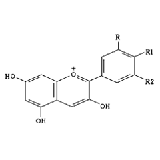| Post Date: | Dec 01,2021 |
| Expiry Date: | Dec 01,2022 |
| Detailed Description: |
Cas No. :84082-34-8
Quantity: 4Metric Tons Specs:Anthocyanidins 25% Payment Method: L/C,T/T,Western Union,Escrow Bilberry Extract Botanical Name: Vaccinium myrtillus L., Vaccinium Uliginosum L.. Product Specification: Anthocyanidins 25% ( by UV) Anthocyanins锛?/font>Anthocyanosides锛?/font>36% (by HPLC) Active Ingredient: 100% Bilberry Appearane: Fine powder Color: Dark Violet Part of the plant used: Fruit Extract method: Grain alcohol Test method: UV CAS No.: 84082-34-8 Molecular formula: C27H31O16 Molecular weight: 611 Molecular structure:
Solubility: Soluble in water and ethanol Safety evaluation: innocuous What is it? Bilberry (Vaccinium myrtillus)is found natively in Europe, northern Asia, Greenland, Western Canada, and the Western United States It occurs in the wild on heathlands and acidic soils. Bilberry (Vaccinium myrtillus)has been used for nearly 1,000 years in traditional European medicine. Herbal supplements of V. myrtillus (bilberry) on the market are used for circulatory problems, as vision aids, and to treat diarrhea and other conditions. In cooking, the bilberry fruit is commonly used for the same purposes as the American blueberry: pies, cakes, jams, muffins, cookies, sauces, syrups, juices, candies and so on. Since bilberries are more fragrant, and have more concentrated flavor and vitamins (like all more natural wild fruit varieties), they are especially well suited for making cough syrups and bilberry wine How does it work? Anthocyanosides are the pharmacologically active constituents of bilberries. They consist of a backbone known as anthocyanidin which is bound to one of three sugars: arabinose, glucose, or galactose. Five different anthocyanidins in bilberry produce more than fifteen different anthocyanosides. The fresh bilberry fruit contains an anthocyanoside concentration of 0.1 to 0.25 percent. Bilberry extract reduces UVA-induced oxidative stress in HaCaT keratinocytes: a pilot study. Benefit and medical uses Function: -Protect and regenerate rhodopsin and cure the eye diseases; -Prevent the cardiovascular diseases; -Antioxidant and anti-aging; -Treatment for mild inflammation of the mucous membranes of mouth and throat; -Treatment for diarrhea, enteritis, urethritis, cystitis and virosis rheum epidemic, with its antiphlogistic and bactericidal action. European cranberry fingerprint:
|
| CAS Registry Number: | 84082-34-8 |
| Synonyms: | ;Cranberry P.E.;Billberry P.E.;Blue Berry P.E.; |
| Molecular Formula: | C27H31O16 |
| Molecular Weight: | 611.53 |
| Molecular Structure: | 
|



